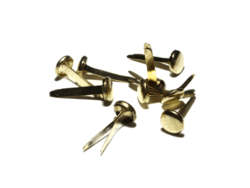Brass fastener

A brass fastener, brad, paper fastener or split pin is a stationery item used for securing multiple sheets of paper together.
A patent of the fastener was issued in 1866 to George W McGill.[1]
The fastener is inserted into punched holes in the stack of paper, and the leaves, or tines, of the legs are separated and bent over to secure the paper. This holds the pin in place and the sheets of paper together. For few sheets of paper, holes can be made using the sharp end of the fastener. A split pin may be used in place of staples, but they are more commonly used in situations where rotation around the joint is desirable. This lends split pins to use in mobile paper and cardboard models. It is shaped somewhat like a nail with a round head and flat, split length. Brass fasteners are made of a soft metal such as brass and the tines are typically of two slightly different lengths. This allows easy separation of the tines. A brass fastener is similar in design and function to the mechanical counterpart split pins.
Brass fasteners are also an industry standard in binding the screenplays in the film industries across the globe.
Brass fasteners are often used as modern scrapbooking embellishments.
References
- Paper Lantern Craft at kid-craft-central.com (reference to usage in article)
- Paper Fasteners